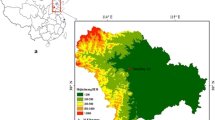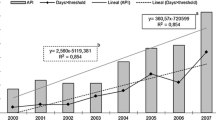Abstract
This study has been focused on airborne pollen concentration in Northern Tunis. Pollen has been detected by a volumetric Hirst-type spore trap. This suction sampler was placed for two hydrologic years in the area of Mornag, northeastof Tunisia (36°40N; 10°17E). Fifty-two taxa were identified with heterogeneous daily pollen concentrations and a dominance of anemophilous plants. The main pollen types detected in the atmosphere were Olea europaea (38.7 and 20.75%), Cupressus (33.57 and 55.4%), Urticaceae (9.22 and 12.24%), Poaceae (3.55 and 3.32%), Mercurialis annua (2.96 and 1.6%) and Amaranthaceae (2.49 and 1.55%). The monthly pollen spectrum indicated a seasonal periodicity of airborne pollen with the main pollen season during spring. Two pollen seasons have been observed during these hydrologic years, due to both Cupressus and Amaranthaceae airborne pollen is represented during winter or spring, and also during autumn and late summer, respectively. Other pollen types represent a long pollen season, i.e., Urticaceae, starting in autumn and following until late spring. Daily pollen concentration showed a different behavior during the flowering season between both years, observing differences related to pollen index. Correlation between daily pollen concentrations of the dominant taxa showed a positive and significant correlation between airborne pollen concentrations of spring-pollinated taxa and mean temperature, but negative with maximum temperature, humidity and rainfall. In the case of minimum temperature, a different response, positive for trees and negative for herbaceous plants, has been observed.




Similar content being viewed by others
References
Aboulaich, N. (2012). Estudio aerobiológico de la atmósfera de Tetuán, NO Marruecos (2008–2011). Influencia de los parámetros meterológicos y modelos de pronóstico. PhD thesis, University of Malaga, Spain.
Abreu, I., Ribeiro, H., & Cunha, M. (2003). An aerobiological study of the Porto region (Portugal). Aerobiologia, 19(3), 235–241.
Alba, F., Trigo, M. M., Galán, C., Ruiz, L., & Sabariego, S. (2003). Aerobiological analysis of Olea europaea L. pollen in different localties of southern Spain. Grana, 42, 234–243.
Alcázar, P., Stach, A., Nowak, M., & Galán, C. (2009). Comparision of airborne herb pollen types in Cordoba (Southwestern Spain) and Poznan (Western Poland). Aerobiologia, 25, 55–63.
Belmonte, J., Canela, M., Guardia, R., Guardia, R. A., Sbai, L., Vendrell, M., et al. (1999). Aerobiological dynamics of the Urticaceae polen in Spain, 1992–1998. Polen, 10, 79–91.
Cariñanos, P., Alcázar, P., Galán, C., & Domínguez, E. (2014). Environmental behaviour of airborne Amaranthaceae pollen in the southern part of the Iberian Peninsula and its role in future climate change. Science of the Total Environment, 470–471, 480–487.
Chafai-Ketfi, L., & Boughdiri, L. (2004). Le contenu pollinique de l’atmosphère de la ville de d’El Hadjar (Annaba, Algerie). Sciences et Technologies, 24, 27–31.
Cuinica, L. S., Abreu, I., Josaquim, C. G., & Da Silva, E. (2014). Effect of airpollutant NO2 on Betula pendula, Ostrya carpinifolia and Carpinus betulus. Environmental Pollution, 186, 50–55.
D’Amato, G., Lorenzo, C., D’Amato, M., & Annesi-Maseano, I. (2014). Climate change and respiratory diseases. Environmental lung diseases, 23, 161–169.
Dahl, A., Galán, C., Hajkova, L., Pauling, A., Sikoparija, B., Smith, A., et al. (2013). Pollen sources. In M. Sofiev & K. Bergmann (Eds.), Allergenic pollen: A review of the production, release, distribution and health impact. Dordrecht: Springer.
Ferreira, B., Ribeiro, H., Pereira, M. S., & Abreu, I. (2015). Effect of ozone in Plantagolanceolata and Salix atrocinerea pollen. Aerobiologia,. doi:10.1007/s10453-015-9415-1.
Galán, C., Alcázar, P., Oteros, J., García-Mozo, H., Aira, M. J., Belmonte, J., et al. (2016). Airborne pollen trends in the Iberian Peninsula. Science of Total Environment, 55, 53–59.
Galán, C., Cariñanos González, P., Alcázar Teno, P., & Domínguez Vilches, E. (2007). Spanish aerobiology network (REA) management and quality manual (p. 61). Cordoba: Universidad de Cordoba.
Galán, C., García-Mozo, H., Vázquez, L., Ruíz-Valenzuela, L., Díaz-De la Guardia, C., & Domínguez-Vilches, E. (2008). Modelling olive cropyield in Andalucia, Spain. Agronomy Journal, 100, 98–104.
García-Mozo, H., Domínguez-Vilches, E., & Galán, C. (2007). Airborne allergenic pollen in natural areas: Hornachuelos Natural Park, Cordoba, Southern Spain. Annals of Agricultural and Environmental Medicine, 14, 63–69.
Ghrabi-Gammar, Z., & Véla, E. (2008). Expertise sur la flore terrestre du site littoral de Sidi Ali el Makki (Ghar el Meleh, Raf-Raf, Tunisie). Rapport peovisoire.
Gómez-Casero, M. T. (2007). Fenologia floral y aerobiologia en distintas species perennifolias de Quercus en la provincia de Córdoba. PhD thesis, University of Cordoba, Spain.
Hirst, J. M. (1952). An automatic volumetric spore trap. The Annals of Applied Biology, 39(2), 257–265.
Jato, V., Rodríguez-Rajo, F. J., Dacosta, N., & Aira, M. J. (2004). Heat and chill requirements of Fraxinus flowering in Galicia (NW Spain). Grana, 43, 213–217.
Kizilponar, I., Civilek, E., Tuncer, A., Dogan, C., Karabulut, E., Sahiner, U., et al. (2010). Pollen counts and their relationship to meteorological factors in Ankara, Turkey during 2005–2008. International Journal of Biometeorology, 4(623), 631.
Laaidi, K., Laaidi, M., & Besancenot, J. P. (1997). Pollens, Pollinoses and Meteorology. La Météorologie, 8(20), 41–56.
Lisci, M., Tanda, C., & Macini, E. (1994). Pollination ecophysiology of Mercurialis anua L. (Euphorbiaceae), an anemophilous species flowering all year round. Annals of Botany, 74, 125–135.
Loumou, A., & Giourga, C. (2003). Olive groves. The life and identity of the Mediterranean. Agriculture and Human Values, 80, 87–95.
Main, C. E. (2003). Aerobiological, ecological and health linkages. Environment International, 29, 347–349.
Martínez-Bracero, M., Alcázar, P., Díaz de la Guardia, C., González-Minero, M. J., Ruiz, L., Trigo, M. M., et al. (2015). Pollen calendars: A guide to common airborne pollen in Andalusia. Aerobilogia, 31, 549–557.
National Institute of Meteorology of Tunis. (2011). Archives des données journalières météorologiques du grand Tunis.
Nilsson, S., & Persson, S. (1981). Tree pollen spectra in the Stockholm region (Sweden), 1973–1980. Grana, 21, 179–182.
Office de Développement du Nord Ouest de la Tunisie. (2004). Valorisation des produits forestiers du Nord Ouest.
Office National de l’Huile, Tunisie. (2015). http://www.onh.com.tn/index.php/fr/l-olivier.
Oteros, J., García-Mozo, H., Hervas, C., & Galán, C. (2012). Biometeorological and autoregressiveindices forpredicting olive pollen intensity. International Journal of Biometeorology, 57, 307–316.
Pérez-Badia, R., Rap, A., Morales, C., Sardinero, S., Galán, C., & García-Mozo, H. (2010). Pollen spectrum and risks of pollen allergy in central Spain. Annals of Agricultural and Environmental Medicine, 17, 137–151.
Radford, E. A., Catullo, G., & Montmolin, B. (2011). Zones importantes pour les plantes en Méditerranée méridionale et orientale, Sites prioritaires pour la conservation. Union internationale pour la conservation de la nature et de ses ressources, Gland, Suisse et Málaga, Espagne.
Recio, M., Docampo, S., García-Sánchez, J., Trigo, M. M., Melgar, M., & Cabezudo, B. (2010). Influence of temperature, rainfall and wind trends on grass pollination in Malaga (western Mediterranean coast). Agricultural and Forest Meteorology, 150, 931–940.
Ribeiro, H., Cunha, M., & Abreu, I. (2003). Airborne pollen concentration in the region of Braga, Portugal and its relationship with meteorological parameters. Aerobiologia, 19, 21–27.
Sabit, M., Ramos, J. D., Alejandro, G. J., & Galán, C. (2015). Seasonal distribution of airborne pollen in Manila, Philippines and effect of meteorological factors to its daily concentrations. Aerobiologia,. doi:10.1007/s10453-015-9414-2.
Skjoth, C. A., Sikoparija, B., Jäger, S., & EAN-Network. (2013). Pollen sources. In M. Sofiev & K. Bergmann (Eds.), Allergenic pollen: A review of the production, release, distribution and health impact. Dordrecht: Springer.
Trigui, A., & Msallem, M. (2002). Catalogue des variétés autochtones et des types locaux. Institution de la Recherche et de l’enseignement agricole de Tunisie.
Velasco-Jiménez, M. J., Alcázar, P., Valles, A., Trigo, M. M., Minero, F., Domínguez-Vilches, E., et al. (2013). Aerobiological and ecological study of the potentially allergenic ornamental plants in south Spain. Aerobiologia, 30, 91–101.
Ziello, C., Sparks, T. H., Estrella, N., Belmonte, J., Bergmann, K. C., Bucher, E., et al. (2012). Changes to airborne pollen counts across Europe. PLoS ONE, 7(4), e34076.
Author information
Authors and Affiliations
Corresponding author
Rights and permissions
About this article
Cite this article
Hadj Hamda, S., Ben Dhiab, A., Galán, C. et al. Pollen spectrum in Northern Tunis, Tunisia. Aerobiologia 33, 243–251 (2017). https://doi.org/10.1007/s10453-016-9464-0
Received:
Accepted:
Published:
Issue Date:
DOI: https://doi.org/10.1007/s10453-016-9464-0




